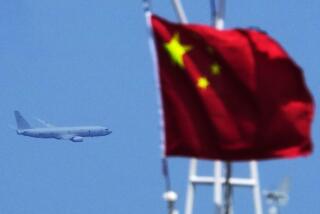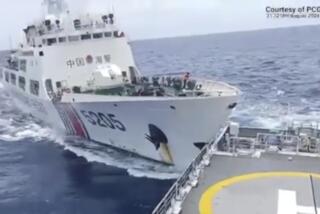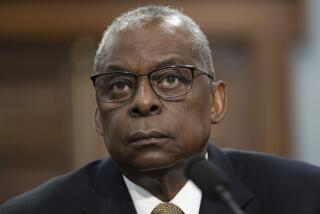Both Sides Push Too Hard in China-U.S. Tensions
- Share via
On Thursday, Chinese and American officials completed two days of negotiations in Beijing on the April 1 collision over the South China Sea between a Chinese naval fighter and a U.S. EP-3 reconnaissance aircraft. Both sides expressed satisfaction that a second day of discussions had enabled a fuller tabling of their respective concerns, with an expectation that additional negotiations would now be scheduled.
Though the meetings were useful for both the U.S. and China, they did little to heal severely strained ties between Washington and Beijing. Beneath the diplomatic niceties the two sides have offered starkly divergent views of the April 1 events and what should be done to avoid comparable future incidents.
Despite the seemingly positive ending of the talks, both countries seem trapped by the separate agendas of their political leaderships. And there is little to suggest that either nation is seriously weighing the longer-term risks of their respective actions on the region as a whole.
Using Beijing’s logic, had there been no surveillance by U.S. aircraft, then no collision would have occurred. So construed, China judges itself blameless for the collision over the South China Sea, notwithstanding persuasive evidence of the culpability of the deceased Chinese aviator, Wang Wei.
U.S. expectations, though judged reasonable and necessary in American eyes, are deemed wholly unacceptable by their Chinese interlocutors. The U.S. seeks Chinese restraints on its patrols in international air space, enhancement of mechanisms to reduce the risks of future incidents and the speedy return of its damaged aircraft.
Satisfaction of these U.S. goals seems an unlikely prospect, especially in the near term. The Chinese demand that the U.S. cease all such reconnaissance flights. Both sides, moreover, know that larger potential “collisions” could await. Within the next week, the Bush administration faces major decisions on future arms sales to Taiwan, an incendiary issue in U.S.-China relations even under more congenial times.
The Bush administration seems in little mood to accommodate the sensibilities of its Chinese counterparts, whom it judges responsible for the tension and political indignities of recent weeks. Some in the administration may further believe that the U.S. needs to signal its determination to reposition U.S. strategy in East Asia, including the potential for a longer-term conflict of U.S. and Chinese interests in East Asia. Though officials in the U.S. and China continue to profess a commitment to advance mutually productive relations, neither side seems prepared to expend much political capital toward that end.
Following return of the EP-3 crew, senior U.S. officials wasted little time in distancing themselves from expressions of sorrow over the death of the Chinese pilot, with Secretary of Defense Donald Rumsfeld presenting videotape to a Pentagon press conference showing how aggressive Chinese patrolling tactics had endangered the lives of U.S. crews. Rumsfeld’s actions were understandable in a U.S. domestic context, but they triggered sharp reactions in Beijing, where many officials believe that the new administration is intent on publicly antagonizing China.
Under such circumstances, Chinese officials see few incentives to conciliate their American counterparts, let alone move toward a shared concept of future relations that minimizes the possibility of a major estrangement.
The Chinese, for their part, do not seem overly exercised by the prospective sharp deterioration in bilateral ties. Some Chinese may believe that confrontational rhetoric and actions are necessary to sober Washington. Others may assume that exaggerated patriotic rhetoric provides the necessary political cover for the inevitability of a more businesslike, if not intimate, relationship with Washington.
But leadership seems missing in action in Beijing. Nearly all the high-ranking leaders were conspicuous by their absence during the negotiations to release the crew in early April, and none seem prepared to identify with closer U.S.-China relations in the current, highly charged atmosphere.
Indeed, in neither capital is there discernible attention to the potential costs and consequences should relations stagnate or deteriorate further. A larger collision of national interests is not foreordained, but it becomes far more likely if neither side identifies such a risk and acts to limit such possibilities. Neither leadership is behaving as if there is much to lose in an emerging test of wills. It may yet take even sharper tests to convince both leaderships that inattention or mutual contempt is the surest path to even larger troubles down the road.










